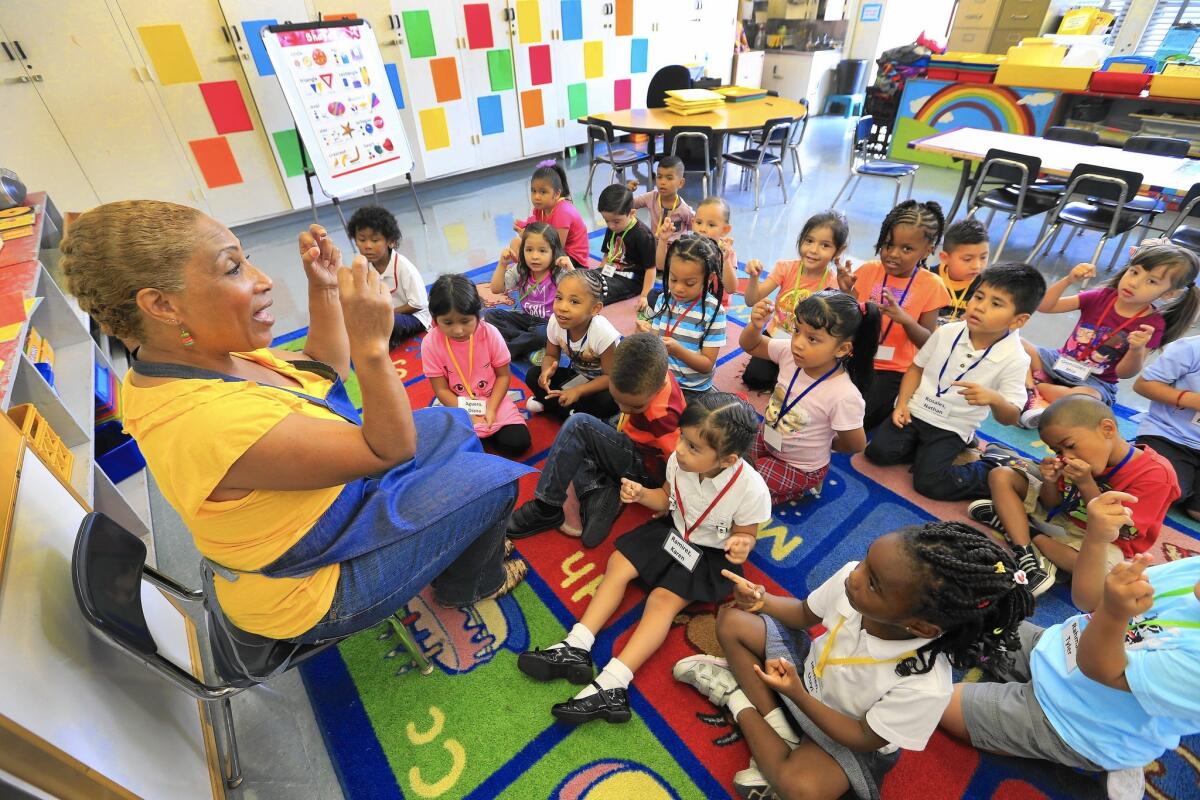Q&A: Understanding L.A. Unified’s new pre-kindergarten programs

Children in expanded transitional kindergarten at 186th Street Elementary School participate in a song with teacher Lisa Harmison.
Understanding all the pre-kindergarten programs can be daunting for parents in L.A. these days. L.A. Unified has some new programs — with new names — that can be a challenge to navigate for what is typically a family’s first foray into public education.
Children in the U.S. are not required to attend school before kindergarten; many, including Californians, aren’t required to enter school until they’re 6 and past preschool age.
But it’s important for children to be in a classroom setting before they turn 5, according to educators and researchers. In California and Los Angeles, that has resulted in a hodgepodge of pre-kindergarten programs. The newest one in LAUSD and in some other California districts is called expanded transitional kindergarten.
What is expanded transitional kindergarten?
Expanded transitional kindergarten, or ETK, is a full-day, six-hour program for children who are 4 years old but will turn 5 during the school year, after Dec. 2. To enroll in one of the 117 programs offered in LAUSD, children must be low-income, learning English or foster youth.
The instructors at ETK are credentialed elementary school teachers, which means they must have at least a bachelor’s degree, along with some student teaching and other requirements. Starting in 2016, LAUSD teachers working with 4-year-olds will need to have taken additional early childhood education classes. (Preschool teachers need a child development permit, which doesn’t require a bachelor’s degree).
For eligible students, first priority for enrollment goes to the students who are within the residential boundaries of that school, and then to the students who are born close to December. If a child is eligible but does not live within the boundaries of a program, space may be available.
What will my child learn in ETK?
Despite the name, the curriculum for these 4-year-olds will adhere more closely to preschool than to kindergarten. Los Angeles schools are using the California Preschool Learning Foundations, which is used in the state’s half-day preschools that serve low-income communities.
The expanded transitional kindergartners will learn lessons primarily through play, said Lisa Harmison, the ETK teacher at 186th Street Elementary School and a 32-year teaching veteran. In addition to social-emotional skills, their goals include:
• Language and literacy (listening, comprehension, concept development — for example, what is a rectangle, what does it look like, what objects are rectangles?)
• Fine motor skills like drawing, and working with pads and keyboards; gross motor skills like spatial awareness and body awareness — learning personal space
• After that, they’ll be able to learn to write their names, know the letters of the alphabet, understand story structure, and expand their receptive and expressive vocabulary so they can recognize and copy phrases that mean something to them, Harmison said.
When did expanded transitional kindergarten begin?
In 2010, when California adopted the Common Core learning standards, a child could enter kindergarten at 4 years and 9 months old (in other words, if they would turn 5 by Dec. 2).
Every elementary school in LAUSD offers transitional kindergarten, which required districts to offer a full year for children turning 5 between September and December. Those younger kids would be exposed to the Common Core kindergarten standards, which were more academically rigorous than previous kindergarten standards. They would not, however, be tested as stringently as kindergarteners are.
Another consequence of the Common Core: Kindergarten has become more academic.
What’s the difference between expanded transitional kindergarten and transitional kindergarten and preschool?
The main differences are the teacher credentialing, and transitional and expanded transitional kindergartens last a full day, while state preschools and some other programs are half-days or less.
There is another difference between transitional kindergarten and expanded transitional kindergarten, at least in LAUSD: Transitional kindergarten is more aligned with Common Core kindergarten standards, which are more academically rigorous than the state’s preschool standards.
What other free preschool options are there in L.A.?
Options depend on a lot of things, including a family’s address, income, whether the child is learning English, foster status and age.
State-run preschools: Income must be at or below 70% of the state median income to be eligible, and there aren’t enough of them. State preschools serve about 175,000 children, which is about a quarter of eligible students, said Debra McMannis, the director of the California education department’s early education division. State Assemblyman Kevin McCarty (D-Sacramento) is trying to secure more funding to expand such preschools.
Head Start programs: These are federally funded, and income must be below the federal poverty line.
School Readiness Language Development Programs: These do not have any income or language eligibility requirements, and they’re at a number of predominantly minority schools. However, 117 of them have been replaced by the expanded transitional kindergartens, and the remaining 173 will become expanded transitional kindergartens in the 2015-16 school year. These are half-day programs that require some parent involvement.
State-funded access centers, called Resource and Referral centers, help parents look into all options for their children.
Twitter: @sonali_kohli
More to Read
Sign up for Essential California
The most important California stories and recommendations in your inbox every morning.
You may occasionally receive promotional content from the Los Angeles Times.











